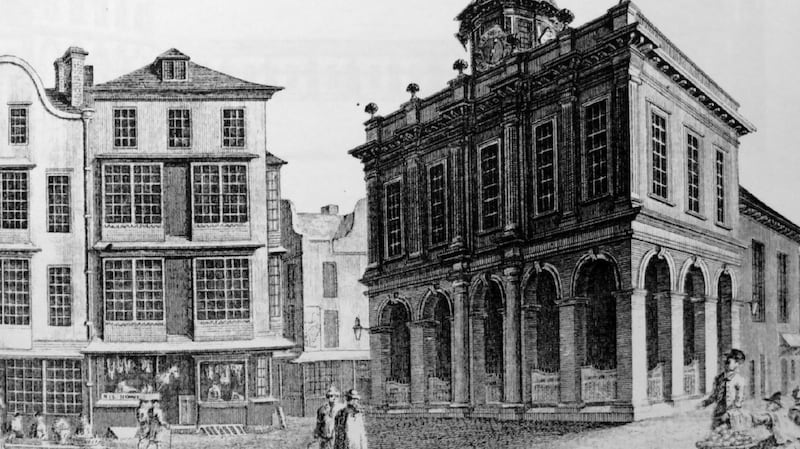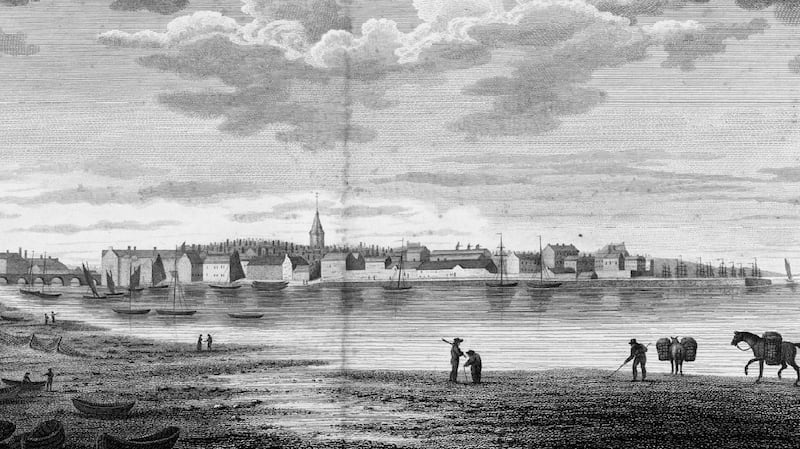High up on the façade of Heuston Station are three coats of arms representing the cities of Dublin, Cork and Limerick. That is probably the only place where the civic symbols of what were once the country’s three largest cities are displayed together.
We tend not to think about Irish cities as a group. They never enjoyed collective status like, say, the royal burghs of Scotland. They have hardly ever displayed common purpose (not at least until the chambers of commerce confederated in Chambers Ireland). Perhaps if the GAA had organised sporting competition by city region rather than by parish and county, things might have been different.
Our cities generate deep tribal loyalties, but this has not been translated into a general interest in Irish cities and their common history. Yet there is a largely untold story: the emergence during the 1700s of a network of unusually large urban communities with populations ranging from 10,000 to 180,000. This didn’t just happen, and it didn’t occur without profound consequences for Irish society at large.
Of the top 10 urban places in 1800, all but one (Belfast) had been trading centres for 500 years or more. Yet by medieval European standards, even at their most expansive moment (in the 1200s), they had been insignificant places. This began to change in the early 1600s: Dublin surged forward to become much the largest urban centre in the country, thriving on the growth of central government and English authority, and surviving several sharp setbacks during the century.
But it is precisely the brilliance of Dublin’s subsequent ascendancy in the 1700s that hides a wider story. Leaving behind their horrific recent history, a small number of provincial cities commenced a long growth cycle, and this continued up until the 1820s. Led by Cork, this soon involved its old rivals of Limerick and Waterford, later including Belfast, Drogheda and Kilkenny.
Highly favourable external markets for Irish agricultural goods and a transformation in the demand at home for shop goods and new-style services drove this growth, and in so doing created a set of far more complex and diverse urban communities. Only Galway among the medieval ports lagged behind.
Cultural distance
The 18th century was – up to the 1790s – a century of peace. But it was also a time of religious repression and Protestant dominance in some, but not all, these cities. There was, for example, a vast cultural distance between the Presbyterian-dominated world of Belfast and a place like Waterford, where wealth from trade was widely distributed across the religious denominations. That was strikingly demonstrated when in the 1790s Waterford’s Big Chapel was replaced by a highly ornate Catholic cathedral, and a short distance away the Quakers launched their model academy, Newtown school.
There were, however, common elements linking all Irish cities. The long peace brought a dividend for everyone. Granted the memories of siege and destruction, expulsion and confiscation were at first very raw, but the widening of overseas trade and ever busier streets created a sense of stability, opportunity and a new equilibrium.
The most concrete sign of changed times was the gradual but quite uncontroversial dismantling of town walls and other old defensive works. By 1800 only in Drogheda and Derry were the walls more or less intact. Most city folk were living outside the former walled areas – those with money seeking out fashionable locations, those without resources crowding into market districts, back lanes and dockland streets.

A second common factor was the physical appearance of cities. Much of what Peter Borsay has christened the “urban renaissance” in provincial England was adapted and slowly adopted in 18th century Ireland. The “rules” of classical architecture became more widely assimilated, brick generally replaced stone as the dominant building material, and elegant “assembly rooms”, market houses and dedicated public spaces became standard features. Timber, tiles and thatch were banished to distant memory.
Weakness
Building controls and street planning were, however, slower to arrive in Irish cities than in estate towns or villages, and for one overriding reason: the relative weakness of city government, even in Dublin. Thus when it came to the development of publicly-owned property – of town commons, parks and reclaimable foreshores –- these were in effect privatised.
The transformation of St Stephen’s Green in Dublin into a residential square had set the pattern in the 1660s: merchants and professionals took out very long leases of blocks of ground, some investing in initial development before subletting to builders, others going into speculative construction themselves. The pattern was reproduced on a more modest scale elsewhere, and the names of such merchants remain on countless streets, quays and lanes in every city.
One consequence of this was the creation of multiple layers of stakeholder. Public control over building use and the redevelopment of street alignments became close to impossible.
The Irish parliament did, of course, establish Wide Streets Commissioners, first in Dublin, then in Cork and Waterford, with unusual powers of compulsory purchase. But the borrowing powers needed to purchase and reshape city streets were for a long time not forthcoming, and it was only in central Dublin that major street replanning and building controls were implemented. Even in Dublin it was a process spanning decades.
![Mayhem in Bridgefoot Street, Dublin, 1798 [Irish magazine, 1812]](https://www.irishtimes.com/resizer/v2/O3YUD4XTVC4CYIVVFGRKODYREA.jpg?auth=c826999d0f5eb3ec220c5f91a2505738f9f49c9bd11f21c9f0d88063b1a0c78c&width=800&height=449)
However, where large well-resourced private urban estates (and competent managers) existed, we do find a measure of urban planning: thus the redevelopment of large parts of later 18th century Belfast, the strategic development of the Gardiner and FitzWilliam estates in Dublin, and, most spectacularly, the creation of Newtown Pery in Limerick city.
Public planning
George Semple, bricklayer and architect, was the unlikely pioneer of public planning in Dublin. He championed the idea of creating what became Parliament Street when commissioned to rebuild Essex Bridge. Semple’s ideas were shaped by what he had seen in London, and by projects in Paris that he had read about. His more prestigious contemporaries in the city all had international experience and a wider knowledge of architectural fashion.
Similarly those who had most impact on the public architecture of Cork (Michael Shanahan) and Limerick (Davis Ducart) knew European cities well. But elsewhere the key figures – Roger Mulholland in Belfast, John Roberts in Waterford – seem to have developed their ideas and designs entirely from books and drawings.
This is a particular example of a general pattern: the way print shaped an evolving urban culture. During the 1700s more books were published and more newspaper titles launched in Dublin than in any other city in the English-speaking world outside London. Provincial printing became commonplace in Cork, Limerick and Belfast.
And urban literacy levels rose strongly everywhere (except in Galway), and through the consumption of monthly magazines and cheap reprints, a taste for polite literature and political debate became deeply embedded. We can begin to see something of Jürgen Habermas’s “bourgeois public space” in the assembly rooms, coffee houses and respectable taverns.
Religious observance also remained a public business, albeit one that for Catholic citizens was fraught with difficulty in the earlier part of the century. Public charities, voluntary organisations and academies remained overwhelming Protestant in tone, although bourgeois Catholics became more involved in voluntary associations by the 1790s. However, the great days of the Catholic religious orders, old and new, lay in the future.
The religious composition of the cities – outside Ulster – was changing. Dublin had a Catholic majority by the 1750s, and the proportion Protestant in the Munster cities was receding as they grew in size. Only in Cork were there signs of religious segregation: the island parishes in the centre of town remained predominantly Protestant, whereas the teeming suburbs to the north and south of the Lee remained overwhelmingly Catholic.
Large garrisons
Every city had a military side, and large garrisons were a feature of all provincial centres except Belfast. Dublin’s barracks were indeed the largest in the then British empire.
This pattern of military deployment was the result of a political trade-off in Williamite London, which had meant that most English (and later Scottish) regiments would be permanently rested in Ireland during peacetime and would be paid for by the Irish taxpayer. The long-standing arrangement was certainly not because of any specific fear that Irish cities were potential powder kegs, but garrisons were from time to time called in to subdue food rioters and faction fighters. However, the city magistracy and unpaid parish officers were at most times sufficient to maintain public order.
But that was breaking down later in the century. Property crime and labour trouble in the workshop filled local newspapers. In Dublin the incidence of capital punishment and transportation was rising starkly. In 1785, a peak year, some 33 people were executed in the capital, nearly all for property offences. The introduction in 1786 of uniformed and armed police on to the city’s streets was not a coincidence.

Much deeper troubles emerged in the early 1790s: French revolutionary ideas gained immediate popularity, enthusiastically so in Belfast. This was intermixed with a nationwide Catholic agitation for political relief, a movement led by Dublin merchants, but with strong support from urban co-religionists in Limerick and Drogheda. Catholic Cork was strangely silent.
Then came the escalation from raucous public politics to a secret conspiracy – prepared to aid a French invasion. This process took strikingly different forms in each urban centre. But the role of city merchants, city money and city print in preparing the hoped-for revolution was paramount, both in Ulster and the south.
Urban churches
The worst of the counter-revolution passed the cities by, but in the bitter aftermath of 1798 that “bourgeois public space” was sundered. Religious affiliation now determined not just political affiliation but everyday sociability. This deepening confessional rivalry was expressed most strongly in the vast rebuilding of urban churches, a competition of the spires that kept the builders happy for decades.
The first great era of city growth was ending in the 1820s. Textile manufacture and food processing, which had given huge employment up to then, was undermined by new economic realities. The Irish ports became more like conveyor belts between rural Ireland and industrial England.
There were many factors at work in this loss of momentum, but the cities of the 1820s had a brave new look. Gaslight was now banishing the night from principal streets. But it was a different story in the darkening poverty of the “back streets” as old industrial neighbourhoods became overwhelmed with pauper migrants, flooding in from a countryside in depression. Dublin’s Liberties were the classic example, but this was replicated elsewhere. Only Belfast, with cotton, then linen manufacturing brought into town, seemed able to break out of the cycle. But for Belfast’s new proletariat there were other troubles to come.
David Dickson’s book The First Irish Cities: An eighteenth-century transformation has just been published by Yale University Press.









